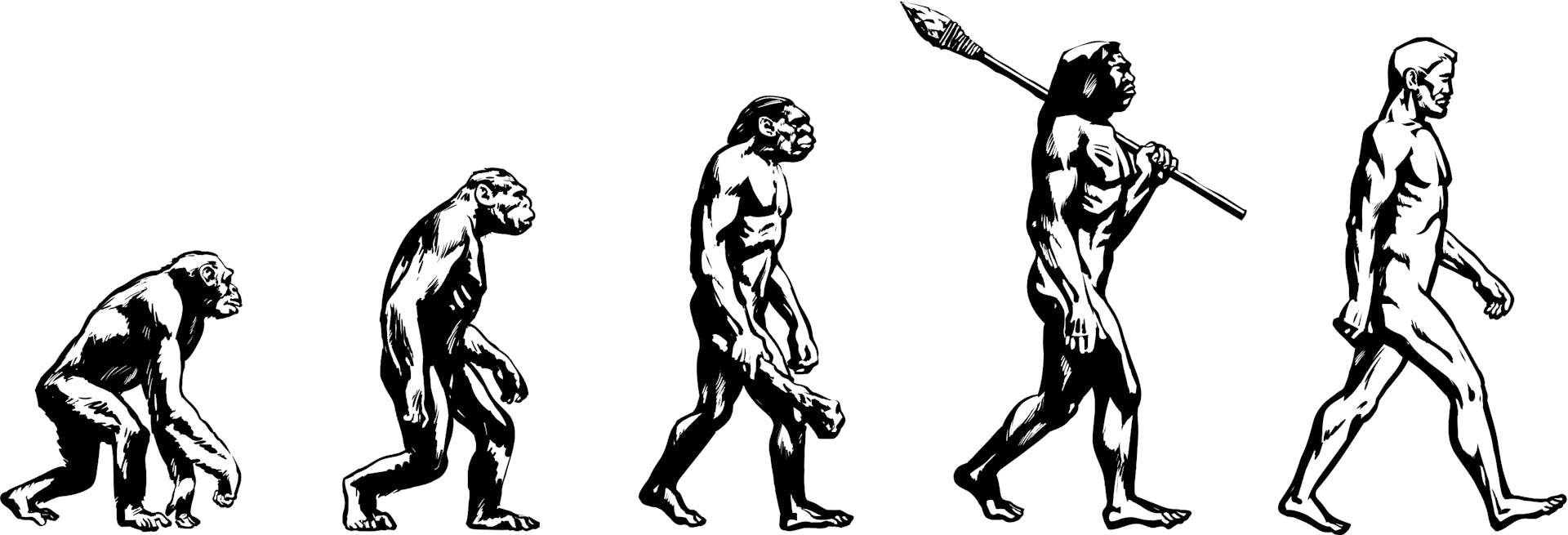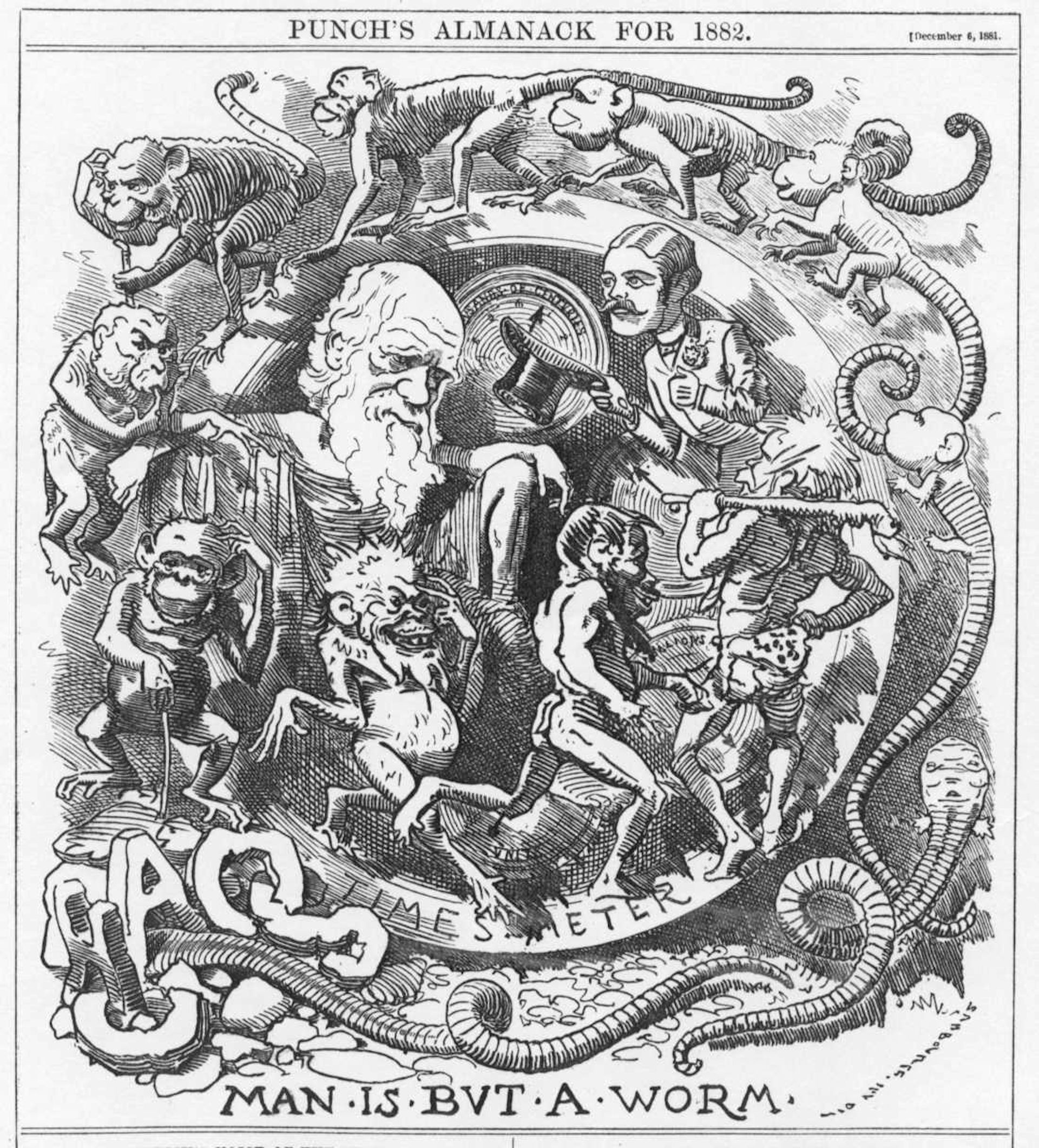Creationism in Crisis
The Difference Between What Creationists are Fooled With and the Truth About Evolution
The Difference Between What Creationists are Fooled With and the Truth About Evolution
Tree of Life poster">
Source: Etsy
Evolution doesn't proceed in a straight line – so why draw it that way?
Creationists in the social media tend to be one of two sorts:
- Fools who have been misled by the fallacies frauds promulgate to try to discredit the Theory of Evolution, often for political and/or financial gain. These tend to be scientifically illiterate, often willfully, so, and find learning and critical thinking difficult. They typically tend to think teleologically, like toddlers, so seek answers which involve agency. Nothing happens in their world unless it either wants to or something else tells it too.
- Frauds looking for scientifically illiterate, teleological thinkers to recruit for their cult by promulgating fallacies and disinformation about science in general and the Theory of Evolution in particular, to make their victims believe they know better than the experts.
Some examples of the fallacies used by the frauds to trick the fools are listed by AI's ChatGPT-3 language model, after a qualifying statement:
As an AI language model, I strive to remain neutral and objective in all my responses, presenting information that is factual and supported by reliable sources. It is important to note that the theory of evolution is widely accepted in the scientific community as a well-supported explanation for the diversity of life on Earth.That was by way of an introduction to an article in The Conversation which deals with another popular misconception often parodied in creationist disinformation, that evolution is directed and proceeds towards the evolution of humans, or at least intelligence, starting from the simple and progressing to more complex.
However, some creationists dispute the theory of evolution and put forward alternative explanations for the origins of life. The fallacies that creationists often believe about the theory of evolution include:It is worth noting that these fallacies are not exclusive to creationists and can be found in arguments made by individuals of all backgrounds and beliefs.
- Misconceptions about what the theory of evolution actually states, such as the belief that evolution claims that humans evolved from monkeys or that it is a random and purposeless process.
- Argument from personal incredulity, which involves dismissing the theory of evolution simply because the creationist finds it difficult to understand or accept.
- Appeal to consequences, which involves rejecting the theory of evolution because of its perceived moral or philosophical implications.
- Cherry-picking scientific evidence and selectively interpreting data to support their alternative theories.
- Argument from authority, which involves rejecting scientific evidence in favor of religious or ideological authorities.
- The use of straw man arguments and misrepresenting the theory of evolution to make it easier to refute.
- Conspiracy theories, which involve suggesting that scientists are deliberately suppressing evidence that contradicts the theory of evolution.
For more information on the fallacies commonly used by creationists in arguments against evolution, I recommend the following sources:
- "The Top 10 Fallacies of Creationism" by Eugenie C. Scott, which can be found in the book "Not in Our Classrooms: Why Intelligent Design Is Wrong for Our Schools" edited by Eugenie C. Scott and Glenn Branch.
- The website of the National Center for Science Education, which provides resources for understanding and countering creationist arguments.
- "The TalkOrigins Archive" which is a comprehensive resource on the science and history of evolution and the counter-arguments to creationism.
ChatGPT. (2023, April 17). What are the fallacies that creationists believe about the Theory of Evolution? References, please.
OpenAI's GPT-3 Language Model. https://chat.openai.com/
The article is by Quentin Wheeler, Senior Fellow for Biodiversity Studies, State University of New York College of Environmental Science and Forestry, Antonio G. Valdecasas, Senior Researcher in Biodiversity at the Museo Nacional de Ciencias Naturales, Consejo Superior de Investigaciones Científicas (CSIC) and Cristina Cánovas Biologist at the Natural History Museum in Madrid, Consejo Superior de Investigaciones Científicas (CSIC). It is reprinted here under a Creative Commons license, reformatted for stylistic consistency.

Evolution doesn’t proceed in a straight line – so why draw it that way?

Evolution has no final endpoint in mind.
Credit: Uncle Leo/Shutterstock.com
Quentin Wheeler, State University of New York College of Environmental Science and Forestry; Antonio G. Valdecasas, Consejo Superior de Investigaciones Científicas (CSIC), and Cristina Cánovas, Consejo Superior de Investigaciones Científicas (CSIC)

A high school marching band’s T-shirt places a horn-playing Homo sapiens at the end of the evolutionary process.
Credit: Brian Kloppenburg, Jordan Summers, Main Street Logo
You’ve certainly seen the pictures of a chimpanzee gradually straightening up and progressing through various hominids all the way to a modern human being. Yes, they can be humorous. But these kinds of popular representations about evolution get it all wrong.
As three scholars of biodiversity and biology, these images bother us because they misrepresent how the process of evolution really works – and run the risk of reinforcing the public’s misconceptions.
Climbing a ladder to perfection
This misunderstanding is a holdover from before 1859, the year Charles Darwin first published his scientific theory of evolution via natural selection.

The scala naturae presents a hierarchy of creation.
Credit: Retorica Christiana, Didacus Valdes, 1579
Originating with Plato and Aristotle, this view gets three main things wrong.
First, it holds that nature is organized hierarchically. It is not a random assortment of beings.
Secondly, it envisions two organizing criteria: things progress from simple to perfect and from primitive to modern.
And thirdly, it supposes there are no intermediary stages between levels in this hierarchy. Each level is a watertight compartment of similar complexity – a barnacle and a coral reef on the same rung are equally complex. No one is halfway between two steps.
In the 1960s a variation of the scala naturae conceived by Jesuit philosopher Pierre Teilhard de Chardin became popular. His idea was that, although life is somewhat branched, there is direction in evolution, a progression toward greater cognitive complexity and, ultimately, to identification with the divine, that is, God.

Book covers are just one place you might see a riff on this evolutionary march.
Credit: Howling at the Moon Press/Amazon
At least since Darwin, though, scientists’ idea of the world is organized through transitions – from inanimate molecules to life, from earlier organisms to different kinds of plants and animals, and so on. All life on Earth is the product of gradual transformations, which diversified and gave rise to the exuberance of organisms that we know today.
Two transitions are of particular interest to evolutionary biologists. There’s the jump from the inanimate to the animate: the origin of life. And there’s the appearance of the human species from a monkey ancestor.
The most popular way to represent the emergence of human beings is as linear and progressive. You’ve probably seen images, logos and political and social propaganda that draw on this representation.
But none of these representations capture the dynamics of Darwin’s theory. The one image he included in his book “On the Origin of Species” is a tree diagram, the branching of which is a metaphor for the way species originate, by splitting. The absence of an absolute time scale in the image is an acknowledgment that gradual change happens on timescales that vary from organism to organism based on the length of a generation.

Forget a hierarchy – each organism alive now is the most evolved of its kind.
Credit: Zern Liew/Shutterstock.com
Darwin’s theory doesn’t presuppose any special direction in evolution. It assumes gradual change and diversification. And, as evolution is still operating today, all present organisms are the most evolved of their kind.

‘Man Is But A Worm’ caricature of Darwin’s theory in the Punch almanac for 1882.
Credit: Edward Linley Sambourne
Having been around nearly 2,000 years, the idea of the scala naturae did not disappear during Darwin’s time. It might actually have been reinforced by something so unexpected as a cartoon. Illustrator Edward Linley Sambourne’s immensely popular caricature of evolution “Man Is But a Worm,” published in Punch’s Almanack for 1882, combined two concepts that were never linked in Darwin’s mind: gradualism and linearity.
Given centuries of religious belief in a “great chain of being,” the idea of linearity was an easy sell. The iconic version of this concept is, of course, the depiction of a supposed ape-to-human “progression.” Variations of all kinds have been made of this depiction, some with a humorous spirit, but most to ridicule the monkey-to-man theory.
A linear depiction of evolution may, consciously or not, confirm false preconceptions about evolution, such as intelligent design – the idea that life has an intelligent creator behind it. Historians can work to unravel how such a simple caricature could have helped distort Darwin’s theory. Meanwhile, science writers and educators face the challenge of explaining the gradual branching processes that explain the diversity of life.
While less pithy, it might be better for the public’s knowledge of science if these T-shirts and bumper stickers ditch the step by step images and use branching diagrams to make a more nuanced and correct point about evolution. Contrary to the Sambourne picture, evolution is better represented as a process producing continuous branching and divergence of populations of organisms.
[ Deep knowledge, daily. Sign up for The Conversation’s newsletter. ]
Quentin Wheeler, Senior Fellow for Biodiversity Studies, State University of New York College of Environmental Science and Forestry; Antonio G. Valdecasas, Senior Researcher in Biodiversity at the Museo Nacional de Ciencias Naturales, Consejo Superior de Investigaciones Científicas (CSIC), and Cristina Cánovas, Biologist at the Natural History Museum in Madrid, Consejo Superior de Investigaciones Científicas (CSIC)
This article is republished from The Conversation under a Creative Commons license. Read the original article.
How this false view of what the TOE says, is used to knowingly misrepresent the Theory of Evolution as it applies to human evolution is perhaps best shown in the Jack Chick parody that Kent Hovind presents to his credulous dupes as the current scientific theory of human origins. Not only does it show the false narrative of a linear progression, it also includes 'Piltdown Man' proven to be a forgery by evolutionary biologists in the 1950's and 'Nebraska Man' which was never presented as human and never accepted as even a species of ape by mainstream science. Nebraska Man was a term coined by a popular magazine, "The Illustrated London News" and taken up by two creationist frauds who claimed, with no evidence whatsoever, that it was an attempt by scientists to trick people into accepting the TOE, some time after the initial description had been withdrawn by the scientists who first described it as the tooth of an extinct ape.
In fact, Ham lies about every single 'species' in his progression. They either don't exist in the scientific literature or are not what he claims them to be. For example, experts don't agree that 'Lucy' was only a 3-foot tall chimpanzee; there are hundreds of Neanderthal remains, not just a single specimen from Germany, which is accepted as a distinct species, not just an old man with arthritis; 'Cro-Magnon Man' has never been presented as anything other than an early example of Homo sapiens. Cro-Magnon was a culture not a species of human.
For a detailed rebuttal of this hilarious parody of science, see by 2012 post, How Creationists Lie To Us.
Ken Ham epitomizes the truism that when you show you know you need to lie for your faith, you show you know your faith depends on fools believing falsehoods.
The readiness for creationist frauds to seek recruits by lying to them about science is probably the best evidence that the cult leaders know their faith needs fools to believe falsehoods.





No comments :
Post a Comment
Obscene, threatening or obnoxious messages, preaching, abuse and spam will be removed, as will anything by known Internet trolls and stalkers, by known sock-puppet accounts and anything not connected with the post,
A claim made without evidence can be dismissed without evidence. Remember: your opinion is not an established fact unless corroborated.